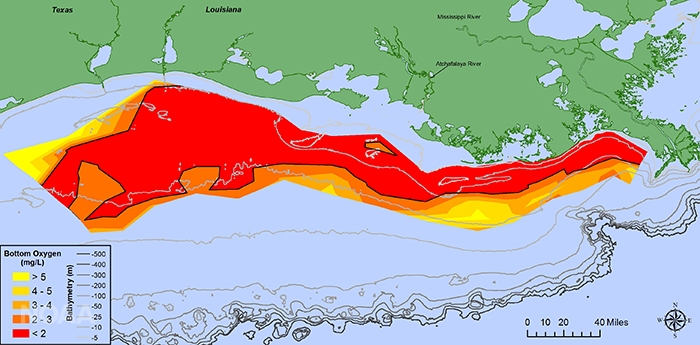Nutrients (Nitrogen and Phosphorous) Sustainability

Distribution of bottom-water dissolved oxygen in the Northern Gulf of Mexico, July 24 – July 30, 2017. The black line denotes 2 mg/L. The dead zone in the Gulf of Mexico in 2017 measured 22,720 square kilometers in area, which is more than four times larger than the USEPA’s Hypoxia Task Force Goal of 5,000 square kilometers (Figure and statistics from https://www.epa.gov/ms-htf/northern-gulf-mexico-hypoxic-zone).
Motivation
Over the past century, humans have dramatically increased levels of terrestrial reactive nitrogen (N) and mobilized phosphorus (P) through industrial fixation of N and P mining. These additional nutrient resources have enabled vital increases in food production—industrially fixed N is now estimated to support around 50% of the global population. The problem lies in losses of these nutrients from human systems into the environment: only about 17% of the N used in agriculture is consumed by humans in agricultural products (Erisman et al. 2008, Sutton et al. 2011), and less than 1% of P mined for food production is retained in the global human population (Reijnders 2014). Nutrient losses to the environment have a wide-range of impacts, including contribution to global climate change, eutrophication of both coastal and inland waterbodies, air pollution, and drinking water pollution (Fan et al. 1996, Costello 2009, Ravishankara et al. 2009, Elgood et al. 2010).
Our Work
The work we do in N and P sustainability is focused on integrating models at different scales that quantify flows of N and P in economic sectors, in individual products, and in the environment so that we can understand how changes in human systems (e.g., location of production, production processes, markets for N–and–P–containing products) will affect N and P emissions to the environment. We are currently working to expand the capabilities of U.S. county scale N and P input models, enabling commodity-specific tracking of N and P impacts over time.
Stakeholder engagement
We are working to involve stakeholders (government officials, researchers, farmers, and consumers) throughout the development process to ensure that model outputs are useful to decision-makers who influence production and consumption of products. If you’re interested in getting involved, please contact us!
Citations
Costello, C., W. M. Griffin, A. E. Landis and H. S. Matthews (2009). “Impact of Biofuel Crop Production on the Formation of Hypoxia in the Gulf of Mexico.” Environmental Science & Technology 43: 7985-7991.
Elgood, Z., W. D. Robertson, S. L. Schiff and R. Elgood (2010). “Nitrate removal and greenhouse gas production in a stream-bed denitrifying bioreactor.” Ecological Engineering 36(11): 1575-1580.
Erisman, J. W., M. A. Sutton, J. Galloway, Z. Klimont and W. Winiwarter (2008). “How a century of ammonia synthesis changed the world.” Nature Geoscience 1: 636.
Fan, A. M. and V. E. Steinberg (1996). “Health Implications of Nitrate and Nitrite in Drinking Water: An Update on Methemoglobinemia Occurrence and Reproductive and Developmental Toxicity.” Regulatory Toxicology and Pharmacology 23(1): 35-43.
Ravishankara, A., J. S. Daniel and R. W. Portmann (2009). “Nitrous oxide (N2O): the dominant ozone-depleting substance emitted in the 21st century.” science 326(5949): 123-125.
Reijnders, L. (2014). “Phosphorus resources, their depletion and conservation, a review.” Resources, Conservation and Recycling 93: 32-49.
Sutton, M. A., O. Oenema, J. W. Erisman, A. Leip, H. van Grinsven and W. Winiwarter (2011). “Too much of a good thing.” Nature 472(7342): 159-161.
Contact Us
Feel free to contact us if you have any comments, questions, or concerns. Follow us on Twitter and/or like our Facebook page to receive updates.
Email: lsrgmines@gmail.com
Twitter: @GroupLandis
Facebook: Landis Research Group